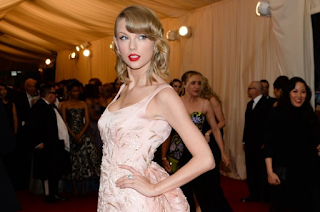 |
| Taylor Swift: Inspiring Young Minds |
"Swift hit number one on the Canadian iTunes chart [in Nov. 2014] with eight seconds of pure static. A glitch in the Canadian version of iTunes release a track called 'Track 3,' that looked like it could be a new track from her upcoming album 1989 but was actually just white noise. Nevertheless, the song soared to the top, beating out her new songs that are actually new music, including "Shake It Off," "Welcome to New York" and "Out of the Woods."The the concerns of these artists is a consequence of how music providers bundle songs into one good. What I will call "tiered bundles" can alleviate the pricing friction on the supply side of the providers. But it starts with the traditional bundling theory.
For information good with low or zero marginal cost, it is relatively costless to add different goods together and sell the bundle. Larger bundles increase profitability because the diversity of consumers will have an overall lower variance of demand since each individual will find something they like (Bakos and Brynjolfsson, 1999). The law of large numbers "average out" unusually high or low valuations and result in a more elastic demand curve around the mean. Sellers then face less uncertainty, at it is a race to become the biggest bundler first (see Nalebuff, 2004).
 |
| Bakos and Brynjolfsson, 1999. |
The problem is that there is such a diversity of quality to bundle that necessitates a more tailored pricing method. It is most likely the case that listeners get more consumer surplus from listening to a new Taylor Swift song than an old Nickleback song. So while music bundlers have made consumer demand more stable, they have moved the uncertainty onto the supply side.
If a bundler is really a platform where a music supply of various qualities meets a music demand of various preferences, it will face a balancing act: increase the bundle to lower demand uncertainty and raise supply uncertainty; or vice versa. On the other extreme, the bundler is simply selling albums which places all the risk on the demand and more certainty on negotiations with the supplier (because the artist's value to the sale of the good is clear).
So what might the music industry learn from this? I would say that the providers should offer tiered bundles. It is reasonable to assume that there are discontinuities to how freely artists will distribute their music. To avoid pricing friction across artist varieties, the provider can offer musicians a menu of pricing options. Their selection will be a self-sorting process that determines the resulting bundles.
There will then be a number of cheaper bundles of varying qualities and sizes. For example, two bundles may have the same price while one contains few, highly popular songs and another numerous, less popular songs. A multiplicity of competing bundles. some overlapping, will provide information to equilibrate prices.
Note that the first company may be able to extract high profits from favorable initial negotiations (high-end artists would be duped into signing because they see a relatively high per-unit revenue).
No comments:
Post a Comment